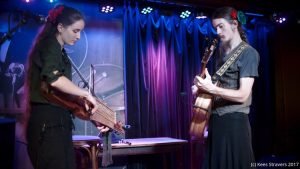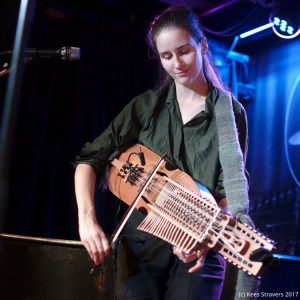Tag Archives: Balfolk
Balfolk! dancing with Wouter en de Draak – Part 1
- 21 Apr
- Helen van der Jagt
- 0 Comments
KNEP – Bestioles (2016)
- 23 Jan
- celtadmin
- 0 Comments

Two talented young musicians, one playing nyckelharpa, the other guitar. Sometimes it doesn’t take more than that to make a beautiful album. The Swiss duo Emilie Waldken and Pascal Rüegger, together known as KNEP, did just that and we at CeltCast are more than happy to introduce their music!
Emilie Waldken studied classical violin, after which she was introduced to the nyckelharpa and Scandinavian music and it was love at first sight. In her own words; ‘the discovery of the nyckelharpa was key in my life.’ She eventually went to Sweden to study Swedish folk music on the Eric Sahlström institutet.
Besides KNEP she plays in the medieval/fantasy band Skoga Obscura which she founded. She also does a lot of solo performances and teaches.
Pascal Rüegger studied music on the Zürcher hochschule der kunste in Zurich. He also went to Sweden to study Scandinavian folk, although his focus was more on dance. He now gives workshops in traditional Nordic- and Balfolk dances. He is also busy with quite a few jazz- and theatre projects.
Together Emilie and Pascal form the duo KNEP. Their first album Bestioles came out on the 13th of February 2016. When asked how KNEP was formed Emilie said: “It was a bit before heading to Sweden that Pascal and I met during a Balfolk ball. First we jammed, slowly a common repertoire was created and one day we stepped on stage and KNEP was born. So our duo is really a classical violinist having a passion for Scandinavian folk fiddling and nyckelharpa who met a jazz guitar and bass player and them ending up together! We like to stick to the Scandinavian style, using the tradition we both studied as much as possible.”
(The complete interview we did with KNEP can be found here)
 With both Emily Waldken and Pascal Rüegger loving Swedish folk-, Balfolk-, classical- and jazz music, it’s no surprise that KNEP’s sound is indeed a blend between Swedish Traditional music, Balfolk and classical chamber music with a splash of jazz.
With both Emily Waldken and Pascal Rüegger loving Swedish folk-, Balfolk-, classical- and jazz music, it’s no surprise that KNEP’s sound is indeed a blend between Swedish Traditional music, Balfolk and classical chamber music with a splash of jazz.
On Bestioles you’ll find 11 lovely folk songs. Introducing us to different types of Scandiavian traditional music and some balfolk too. Five of the songs are Polska’s, one is a Circassien Circle. There is a Waltz, a Scottish and two Mazurka’s. Five songs are traditionals, Pascal wrote four and Emilie has five to her name. For the fast mathematicians, yes that adds up to more then eleven, but some songs are actually two tunes blended together. Something you will surely notice reading the song-titles. All arrangements are by Emilie and Pascal. The latter is also responsible for recording Bestioles.
The first song MCP + La verte shows all the duo’s strong points. It starts with a jazzy rhythm played by Pascal on guitar and he is soon accompanied by Emilie’s nyckelharpa. Although the first time I heared the music I mistakenly thought it was played with a octavharpa. Not true Emilie told me. Her nyckelharpa has a 4-row keyboard, which explains the deep almost cello like sound on this (and other) songs. As the nyckelharpa’s melody on MCP + La verte is in the range of a cello, you would expect these two combined compositions by Pascal to be melancholic, but they are not. It’s actually a cheerfully played Polska, especially the second part La verte.
The second song Chévrefeuille (French for Honeysuckle) is a composition by Emilie. This song is still evolving when they play it live with Emilie adding new parts to it on a regular basis. Again, a nice cheerful song, with Pascal on low whistle. The composition has a lot of variations on the main theme and changes in tempo, keeping it interesting until the last note.
Polska från Dorothea starts with a lovely nyckelharpa intro from Emilie, with Pascal´s guitar joining in. Both instruments blend into a beautiful, gentle piece of music. By now it’s clear that both Emilie and Pascal are excellent musicians. Although all songs are instrumental, you don´t miss vocals. As is to be expected from well composed classical music, the instruments themselves are the voices. In the artwork Knep tells that this Polska has been among their favourites for a long time. It could well be my favourite too.
Celle-ci is a Mazurka. It´s also a solo piece for guitar and it´s beautiful, starting real small, delicate and tender. The song shows how beautiful classical acoustic guitar can be, when played by a skilled musician. Another personal favourite of mine.
The uptempo Le Troll du Chateau de Joux + The Gallowglass brings us to another Balfolk dance classic. The Circassien Circle dance. At this point I noticed another strong point of the CD. Its variation. I am taken from dance tunes to delicate solos. One moment the guitar will lead the way, the next song the nyckelharpa takes center stage. From open chords to rhythm, from Polska’s to a Waltz, the songs are never the same. I really have to compliment KNEP on the song choice and the placement of them on the album. It is so well balanced, so well thought out that it keeps being interesting.
Not all songs are Swedish folk inspired. Suka-fiol is a Waltz Emilie wrote when she heard about the Suka, a special fiddle from Poland. Maybe it sounds Polish, maybe not, but it’s definitely a nice Balfolk song.
 Eikelandsosen
is a solo piece for nyckelharpa. And here I have to compliment Pascal on his recording skills. The whole album is recorded with minimal usage of effects, giving it a direct, pure and honest sound. In this song it works so well. You can really hear all the ‘clicks’ of the nickelharpa keys being touched. If you close your eyes you can just imagine Emilie sitting next to you, playing you this wonderful instrument.
Eikelandsosen
is a solo piece for nyckelharpa. And here I have to compliment Pascal on his recording skills. The whole album is recorded with minimal usage of effects, giving it a direct, pure and honest sound. In this song it works so well. You can really hear all the ‘clicks’ of the nickelharpa keys being touched. If you close your eyes you can just imagine Emilie sitting next to you, playing you this wonderful instrument.
The last song I want to mention is L’autre Route, a delicate duet between guitar and nyckelharpa. A worthy end to this beautiful album. Bestioles nicely fills in the gap between Balfolk, as played by the likes of Finvarra, and Baroque style chamber music. It’s not an album that will make you jump and run through your house dancing. It’s an album you want to play to calm down and forget the stress of the day. It leaves you feeling positive and relaxed. A great value nowadays.
– Cliff
– Concert photo’s courtesy of Kees Stravers.
– Band portrait courtesy of Knep.
EMIAN – Khymeia (2016)
- 21 Dec
- celtadmin
- 0 Comments

Six years ago on December the 21th 2011, the day of the winter solstice, EMIAN was formed. To celebrate that moment, we have decided to write an introduction for their latest album Khymeia. Way overdue of course, but better late then never.
From the moment I put Khymeia, the second album from the Italian Pagan Folk band EMIAN, in my CD-player, it started to grab me. At first it surprised me, then their music started pulling me in… note by note. By the time the 5th song La Cama Nupcial was playing there was no turning back. I was hooked! The musicality, the originality, the talent. This is a CD well worth buying… But now I’m getting wàààày ahead of myself, so first things first.
EMIAN is a 4 person Pagan Folk band from Italy. As it was formed at the winter solstice 2011, it’s no big surprise the band get its inspiration from their own southern Italy Pagan roots, Mother earth, nature and ancient cultures. They do so with songs by their own hand, inspired by Celtic, North-European and Mediterranean folklore, and songs they collected from those periods, be it in Italian, Finnish, French, English or Gaelic (Both Scottish and Irish Gaelic), taking influences from shamanistic chants to medieval ballads.
The band members are:
– Aianna Egan (Anna Cefalo) on vocals, celtic harp and castanets (those are fun).
– Emian Druma (Emilio Antonio Cozza) on vocals, hurdy gurdy, nyckelharpa, fiddle, flute, percussion, medieval bagpipe and the Persian santur, an instrument that looks a lot like a hammered dulcimer.
– Rohan (Danilo Lupi) on acoustic bass, Irish bouzouki, the tin and low whistle and backing vocals.
– Mártín Killian (Martino D’Amico) on drums, percussion, guitar and backing vocals.

The intro song Tribus Hirpeis is followed by a vocal piece written by themselves. Hyria starts with an enchanting harp melody supported by the Persian santur, giving the song a Greek feel. Anna quickly joins in. She has a beautiful warm yet strong voice. A pleasure to listen too. After this ballad-esque start the acoustic bass joins in, giving the song a surprising modern feel. This in contrast to the use of the tribal bass sound from the didgeridoo, well-known from other Pagan Folk bands. Surprising at first, but it actually fits perfectly. With the violin joining in with the harp melody, the band captivates you. Without warning you drift into Khymeia‘s musical world. One you will enjoy.
La giga del lupo starts with a Celtic harp jig that takes me back to the Pagan folklore days of OMNIA, but a loud ‘yehaa’ brings in Emilio’s violin. Playing a lovely Irish folk melody and making it into a perfect instrumental Balfolk dance song. Short, but therefore more powerful.
 Rebys is a strong, cheerful and up-tempo song with Spanish Sephardic lyrics, driven by the rhythm of the drums. The Italian language just works wonders in this style of music. Again Anna Cefalo shows she is a really good singer, but she is not alone. It becomes clear that all the band members are talented musicians. A lot of things are happening in the music: harp, Irish bouzouki, hurdy gurdy, percussion, castanets, but also musical breaks, sudden twists in the rhythm, it’s all there. This is really a CD you want to listen to with headphones, just to be able to hear everything that’s hidden in the music (or play it very loud in the living room… when the neighbours are not at home). Midway through this song there is a sudden break in the music, taking it back to only Anna Cefalo’s voice and harp, before the band kicks in again. This build-up is repeated at the end of Rebys.
Rebys is a strong, cheerful and up-tempo song with Spanish Sephardic lyrics, driven by the rhythm of the drums. The Italian language just works wonders in this style of music. Again Anna Cefalo shows she is a really good singer, but she is not alone. It becomes clear that all the band members are talented musicians. A lot of things are happening in the music: harp, Irish bouzouki, hurdy gurdy, percussion, castanets, but also musical breaks, sudden twists in the rhythm, it’s all there. This is really a CD you want to listen to with headphones, just to be able to hear everything that’s hidden in the music (or play it very loud in the living room… when the neighbours are not at home). Midway through this song there is a sudden break in the music, taking it back to only Anna Cefalo’s voice and harp, before the band kicks in again. This build-up is repeated at the end of Rebys.
The next song La Cama Nupcial starts off as if it’s another break, with only Anna’s harp again. If you wouldn’t look at your display at that point, you would certainly think you were still listening to Rebys. Brilliantly done. It clearly shows EMIAN’s compositional skills.
La Cama Nupcial itself is a beautiful duet between harp and flute, a bit like the instrumental duets Sowulo are known for. I always make notes while listening to an album for a review, and at this point I wrote: “I’m now officially hooked!”.
Khymeia is a beautiful album that fits well in the realm of OMNIA, Faun, Sowulo and Rastaban. Not that EMIAN is a copy of any of those bands. They have their own unique style. It’s just to give you, the listener, an idea of what to expect.
 The first song not written by EMIAN themselves, and the 6th on the album, is El Viaja de Maria. To show how diversely skilled the members of EMIAN are, it starts with a bit of overtone singing by Emilio Cozza. This is a singing technique where you sing a low tone while making an ‘oe-oo-eu’ sound. When a singer is skilled and has had a lot of practise, his or her vocal chords can make a second tone, higher then the first. The song itself is a well-known traditional
(In Extremo
recorded a nice version), but EMIAN re-arranged it so it fits their style perfectly. The long instrumental intro will draw you into the song.
The first song not written by EMIAN themselves, and the 6th on the album, is El Viaja de Maria. To show how diversely skilled the members of EMIAN are, it starts with a bit of overtone singing by Emilio Cozza. This is a singing technique where you sing a low tone while making an ‘oe-oo-eu’ sound. When a singer is skilled and has had a lot of practise, his or her vocal chords can make a second tone, higher then the first. The song itself is a well-known traditional
(In Extremo
recorded a nice version), but EMIAN re-arranged it so it fits their style perfectly. The long instrumental intro will draw you into the song.
Níl Sé’N Lá is actually a Scottish Gaelic song but in the arrangement of EMIAN it becomes a Greek traditional, driven by the percussion. Weird in a way, but it works. It works really well actually. It’s something that EMIAN does so well: they blend their influences together, not only in their song choice alone but also within the songs themselves, making them way more interesting.
I’ll stop here because I don’t want to give away every song on this album. It’s much more fun to get Khymeia yourself and start discovering EMIAN’s musical world . Just listen to the instrumental song La Gavotte for instance. A fun French Balfolk song that, again, finds itself somewhere between the music of Omnia and Faun. Chêne blanc is another up tempo, instrumental dance song. My personal favourite. Kuulin Äänenn is a Finnish (!) ballad, beautifully sung by Anna and Martino D’Amico, but then, halfway, turned into a cheerful Balfolk song. Listen to that flute solo in the end! Surely this song is the high-light of every concert they play. My last personal tip is Le Due Sorelle, an Italian translation by Anna Cefalo of the famous song The Twa Sisters. I have to say the Italian language is very suitable for a ballad like this.
With Khymeia, EMIAN has put themselves right in the top of the pagan folk scene. In my eyes a must have album for everyone who loves this particular style of music.
– Cliff
– Concert photos taken at Castlefest 2017, courtesy of:
Mariëlle Groot Obbink
Winter Castlefest – Balfolk with Andoorn
- 25 Nov
- Helen van der Jagt
- 0 Comments
Waking up in the wonderful world of
Castlefest
with some morning gymnastics in the form of
Balfolk
! with music provided by
Andoorn
.
Review ‘Martine Kraft – Huldreblod’
- 08 Oct
- celtadmin
- 0 Comments
A little over a week ago we introduced Cliff to you all as our latest CeltCast family member and one of the things he said he would be doing for us is reviewing albums. So, it’s time for the first one! 🙂Having Martine Kraft‘s amazing song “Himmelfot” as our Monthly Marker this month, we thought it would be a good idea to start with a review of the album this song is from, Huldreblot, which was released last May. In his review Cliff certainly shows what he’s made of, as he delves deep into not only the amazing album that it is, but also into his emotional connections with other music that was triggered by it and he clearly did research to provide the reader with not only relevant but also very interesting background information! Curious yet? Good! 😀 Head on over to the review. You won’t be disappointed!
